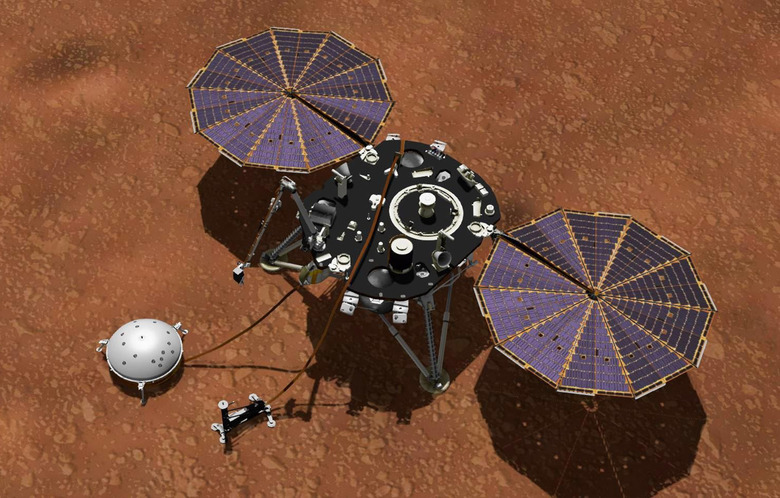NASA's Mars InSight Lander May Be In Deep Trouble
Of all the missions that NASA has sent to Mars over the past decade, the InSight lander might be the one that has caused the most problems. The lander successfully touched down on Mars a couple of years back and it quickly became clear that something wasn't working as intended when it deployed its self-hammering "mole" probe. The InSight team spent months and months trying to get it to work before eventually giving up. At the same time, its seismic sensors have returned data, but a good chunk of that data is believed to have been created by the brisk wind moving over the surface and not actual "Marsquakes."
Still, despite these shortcomings, NASA has been able to collect a lot of valuable data from InSight, and it's far from a failure. In fact, it performed well enough that NASA granted the two-year primary mission (which ended in late 2020) a two-year extension. Unfortunately, the probe is now in an emergency hibernation mode due to the dust that is covering its solar panels. If NASA doesn't get lucky, the lander may face the same fate as the Opportunity rover, and that's not good.
You'll probably remember the fate of Opportunity, which found itself caught in a planet-wide dust storm that cut off its power when light couldn't reach its solar panels. The freezing temperatures eventually killed the rover and it never woke back up. InSight isn't nearly as old as Opportunity was when it dealt with its hardships, but the lander is still struggling in the face of dust accumulating on its solar array.
According to a new NASA post, InSight's panels are currently generating a mere 27% of the power they were designed to provide. That lost power is a direct result of the dust that has built up on the lander's solar panels since it landed.
Additionally, InSight's team chose a landing site in Elysium Planitia, a windswept plain on the Red Planet's equator that receives lots of sunlight. It was hoped that passing dust devils might clean off the panels, which happened many times with Spirit and Opportunity, allowing them to last years past their design lifetime.
Unfortunately, InSight hasn't been nearly as lucky. It has spotted many dust devils during its time on the planet but none have lined up with the lander, and the dust just keeps piling up. The more dust that settles on InSight, the less power its panels can provide. So, in order to give the lander the best chance of surviving until its panels are (hopefully) cleared, NASA has put it in a hibernation mode to save power.
In the short term, NASA is going to have InSight take some photos of its solar array to get a better idea of how dusty they really are. They'll then fire up the small motors that controlled the deployment of the array when the probe landed to see if they can vibrate some dust off the panels. Aside from that, NASA can merely wait and hope that a dust devil sweeps over the lander and cleans its panels.
